Sven Botman’s stock has undoubtedly risen since he joined Lille from Ajax for €8m in the summer.
The 20-year-old Dutchman, who stands at a towering 193cm (6’4”) tall and weighs 85kg (187lbs), has played every minute for Les Dogues in Ligue 1 this term since making his move to Stade Pierre Mauroy and helped the Hauts-de-France-based club to take 36 points from their first 17 games of the 2020/21 campaign, leaving them sitting in second place in France’s top-flight at this stage of the season, level on points with top-of-the-table Olympique Lyon and one point ahead of third-placed PSG.
His important role within Lille’s side in terms of game time has been backed up by impressive on-field displays, which has led to clubs such as Liverpool and Manchester United being linked with January moves for the player, with Lille said to value the €8m summer signing at €50m, though some have claimed that they may be open to accepting €30m for Botman due to their recent well-publicised financial issues.
In this tactical analysis, in the form of a scout report, we’ll provide analysis of some of the key aspects to the left-footed centre-back’s game. We’ll analyse how he fits into Christophe Galtier’s tactics at Lille, his aerial ability, 1v1 defending ability, recovery pace, passing quality, and evaluate what the main strengths and weaknesses are to this highly-rated prospect.
Botman’s positioning
Galtier’s Lille side plays almost exclusively in a 4-4-2 shape and Botman occupies the left centre-back position within that system.
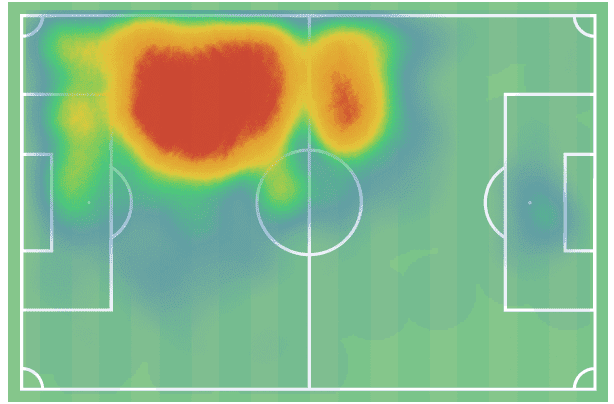
The heatmap above shows us Botman’s average positioning for Lille in the 2020/21 campaign. We can see that, as you’d expect, he spends the vast majority of his time in the area just to the left of the centre of the pitch in his own half, but one particularly notable element of this heatmap is how wide the red area of this heatmap stretches.
This indicates that Botman doesn’t only remain in central areas but spends almost as much time in slightly wider positions and this is an evident feature of his game both in and out of possession.
It’s not too surprising that Botman gets somewhat wider in possession, given that Lille’s shape will naturally stretch out more on the ball, compared to when operating in a more compact block out of possession.
However, this allows us an opportunity to touch on an important element of Botman’s game, which is his high level of comfort with defending in wider areas.
The Dutchman likes to push out into wider areas to engage in defensive duels with opposition players 1v1. This is particularly useful should Lille’s left-back, usually Domagoj Bradarić, get beaten or caught out of position during a moment of transition.
Botman’s comfort with defending out wide provides something of a safety net and, as we’ll now analyse in greater detail, he’s very effective at defending in these 1v1 situations, making him a very useful tool for his side in these scenarios, which is a big reason why he’s spent so much time in those positions this term.
Botman’s defensive duels
Simply put, Botman is a very difficult player to get past. This season, he has a 79.79% defensive duel success rate. This is the highest defensive duel success percentage of any player in Ligue 1 for the 2020/21 campaign.
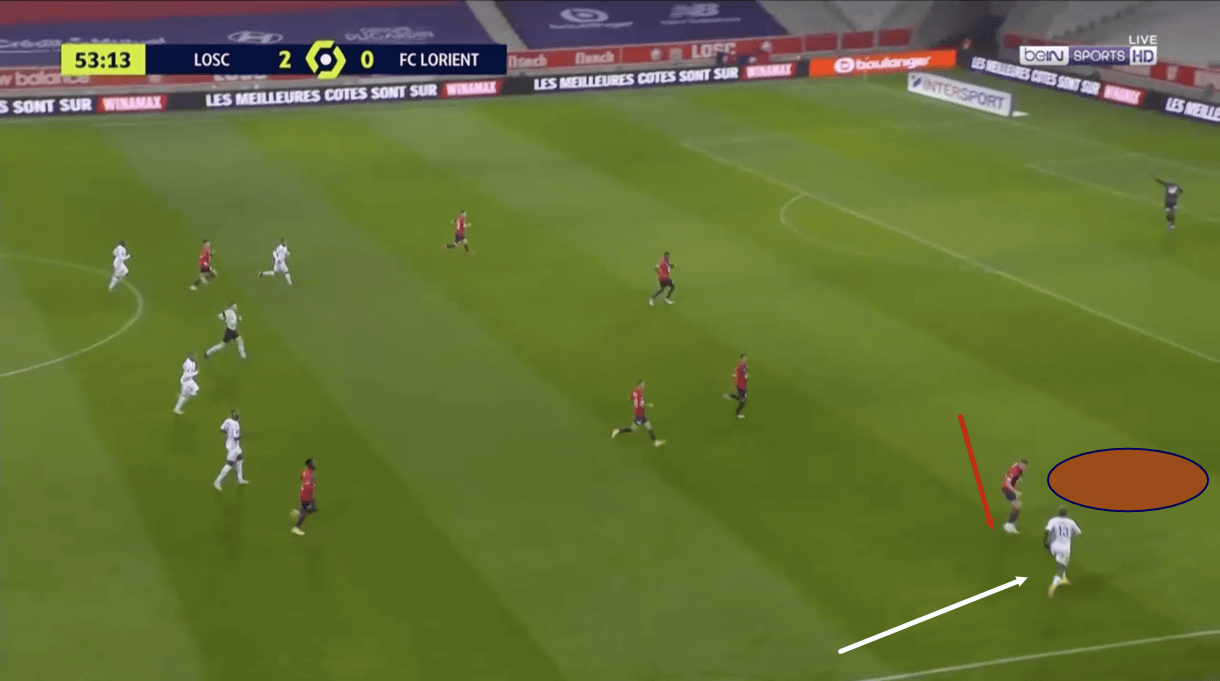
The image above shows us an example of Botman engaging an opposition player out wide, as we’ve established he likes to do, during Lille’s 4-0 win over Lorient earlier this season.
Some details about how Botman handles 1v1s and defensive duels which stand out as potential key reasons for his impressive defensive duel success rate are his patience, the distance he maintains between himself and the opposition attacker, and the exact position he takes up when engaging the player and the space he leaves open for them to run into.
As for his patience, while Botman has the best defensive duel success rate in Ligue 1 this term, he doesn’t engage in defensive duels left, right and centre. If he did, then it may be unlikely that his success rate would be as high. He’s engaged in 5.19 defensive duels per 90 in Ligue 1 this term, which isn’t a low number but also isn’t a staggeringly high number.
This shows us that Botman is very judicious in terms of when to engage in defensive duels. He’s not the world’s most aggressive defender despite being very capable of defending aggressively, in positions like this, when required. One of his biggest strengths in his defensive duels is how he weighs up situations and usually demonstrates plenty of patience before deciding to engage an opposition player.
Additionally, when he approaches players and engages in 1v1s with them like this one above, Botman very rarely dives in. In fact, he doesn’t actually tackle much at all. You only really see him commit to a full-on tackle in a last-gasp situation, for example, if he’s quickly reacting to a ball falling to an opposition player inside of the penalty box or if he’s chasing to close down a player who’s been played in behind the defensive line.
This lack of a tendency to tackle sees Botman commit very few fouls. He’s fouled players just 0.33 times per 90 in Ligue 1 this term, making him a level-headed and reliable defender.
In a situation like this, where he’s weighed up the scenario and made the decision to engage the player, he’ll know exactly how he wants the engagement to go and that will not usually see him commit to a tackle unless the opposition player pulls something special out of the bag to throw him off his game.
Technically, Botman is very good in these situations, it’s natural for him to distance himself from the attacker appropriately, not get right on top of them and approach them side-on as we see above.
However, we can also see that though Botman covers the inside very well, essentially blocking off the left-footed Lorient forward Terem Moffi from cutting inside, via his positioning, and showing him the outside.
This is particularly effective in this situation as he’s showing the attacker onto his weaker foot, but showing the player on the outside is a fairly common feature of Botman’s game regardless of who he comes up against, due to how effective he is at preventing players from taking advantage of the space he does afford them.
In the image above, Botman is almost teasing the forward and goading him into attacking this space the defender is leaving open but this is a calculated move from Botman and something of a trademark to his game in these 1v1 scenarios because he’s so good at keeping himself in the correct position, between the attacker and the goal.
He manages this, firstly, via his intelligence, but also via his physical traits of balance and agility, to remain in the correct position and react quickly to the dribbler’s movement, which he’s very good at.
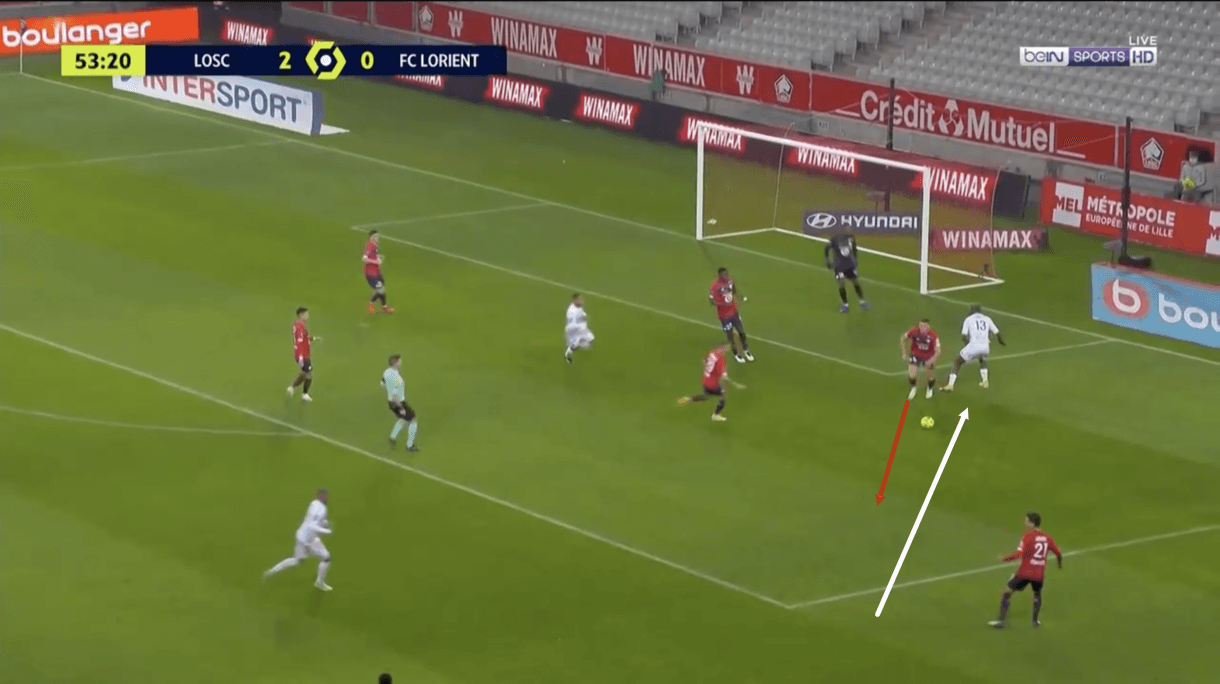
As this next image shows us, Moffi did take the bait and attack the outside, and Botman did react well, keeping himself between the attacker and the goal until the Lorient man eventually ran into him like a cul-de-sac.
As is standard, the Dutchman prevailed from this 1v1 battle and came away with the ball. This highlights how Botman primarily defends with his brain. Yes, he relies on his physical traits as we’ve mentioned, but the way he excels in the mental aspects of the defensive game really set him apart.
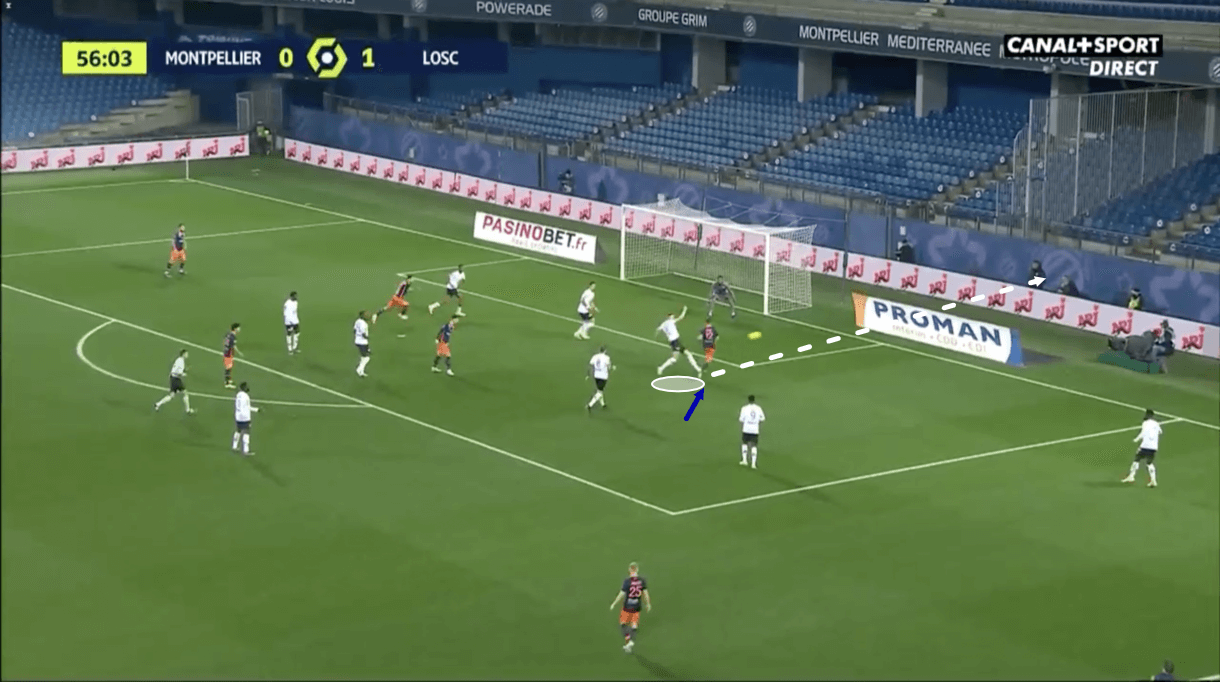
As mentioned, while Botman rarely has to tackle, he does make last-ditch tackles when required and he’s good at doing that too. The image above provides us with an example of one such occasion.
Just before this image, the ball broke loose inside of the Lille penalty area and fell to the feet of one Montpellier player, however, as the player set himself to shoot at goal, Botman was quick to react and manager to pull off a last-ditch tackle to put the ball out of play.
This highlights the 20-year-old’s impressive reactions and ability to pull off a bit of calm and composed defensive work at a crucial, high-pressure moment.
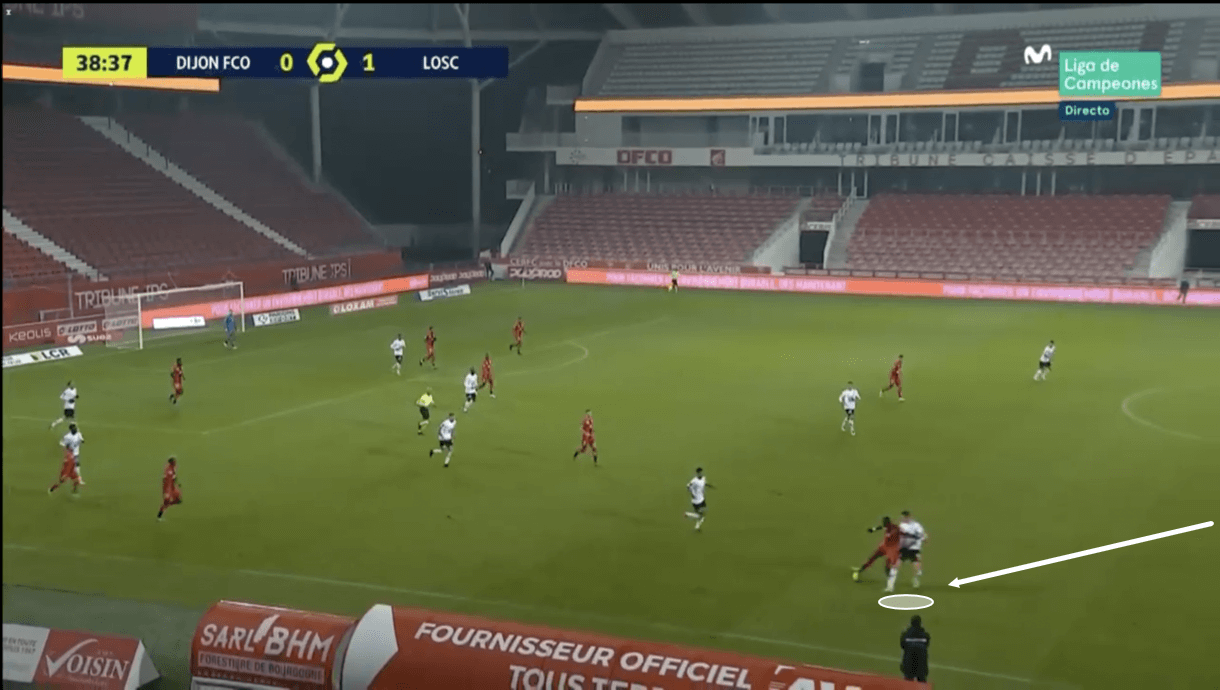
Another important part of Botman’s defensive game is how well he uses his large frame. The Dutchman imposes himself on opposition attackers with his defensive quality, as well as his strength and balance, highlighted in this image above, where he can be seen engaging an opposition attacker out wide, with Dijon attempting to break and hit Lille in transition.
As this attacker received the ball with Botman right behind him, he attempted to back into the Dutchman to hold up the play, in an attempt to bring his teammates into the game as they began to break, however, Botman has made it very difficult for forwards to back into him like this during the 2020/21 season and this passage of play shown above was no different.
The centre-back held his ground, imposed himself on the attacker trying to back into him and this resulted in the Dijon man losing his balance as the stronger Botman battled him off the ball, cleanly winning back inside the opposition half, ending their counter-attack and kickstarting a counter-attack for Lille. This piece of play highlights the centre-back’s strength – another key positive to his game.
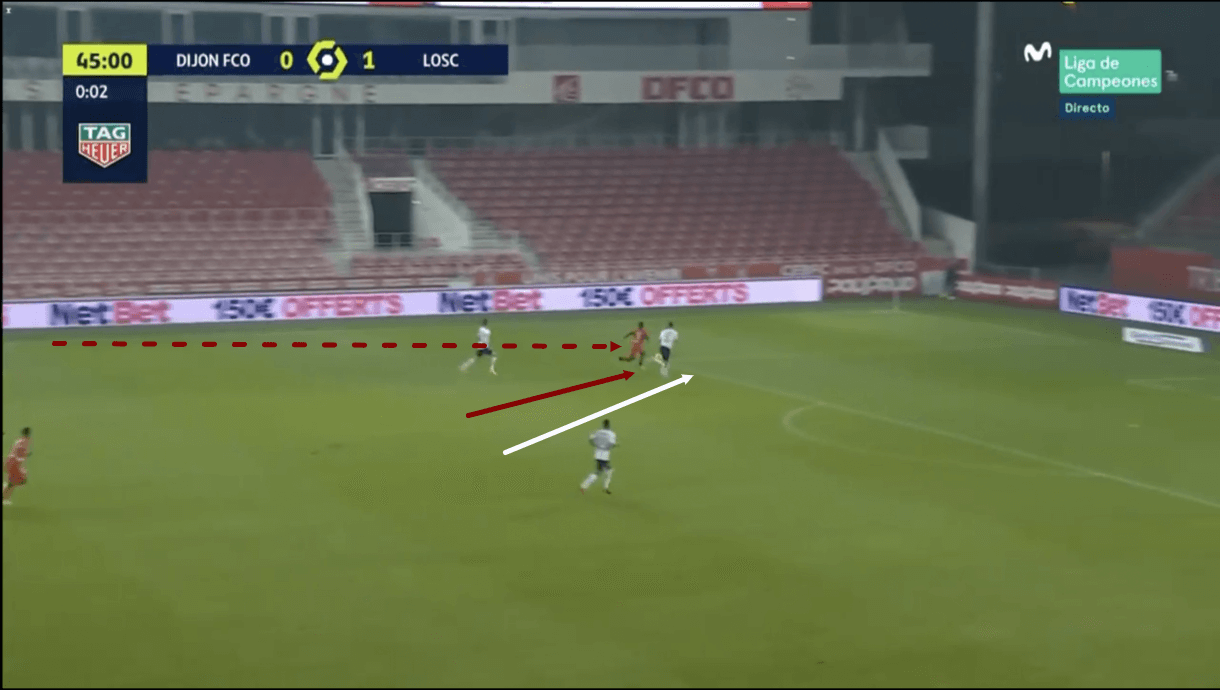
Botman’s strength is more impressive than his speed. That’s not to say that he’s slow, by any means, but there is some room for improvement in this area of his game. That said, as the image above shows, he’s still been capable of tracking runners in behind the defensive line and recovering effectively when that last line has been breached this term.
More often than not, Botman’s pace isn’t a problem in these situations. He’s not the slowest once he’s built up a head of steam and capable of keeping up with most dribblers even if they do manage to get played in behind the defensive line. This makes him a fairly reliable centre-back in terms of covering in behind.
However, there have been a couple of occasions this season where a particularly quick player has breached Lille’s last line and caused Botman problems, as he’s either just not been quick enough, or he takes to long to accelerate up to his top speed, so this area of his game could potentially be exploited more.
There are quicker centre-backs out there than Botman, even when taking into account his size, but, again, he’s not a particularly slow player and for how Lille play, his pace has been more than sufficient enough.
Botman’s passing
Botman is a good ball-playing centre-back and Lille have made the most of his on-the-ball ability this term, with the Dutchman playing a central role to their game in possession, as is evident by the fact he’s completed an average of 59.02 passes per 90 in Ligue 1 this season – the 27th-highest number of passes per 90 that have been completed by anyone in France’s top-flight during the 2020/21 campaign – with a solid 90.27% pass success percentage.
The Dutchman doesn’t just play lateral or backwards passes to achieve these impressive numbers, however, as he’s been one of the best ball progressors in France’s top-flight this season, with the 20-year-old playing an average of 11.54 progressive passes per 90 this term while achieving an 80.38% progressive pass success rate. Only five players have played more progressive passes per 90 than Botman in Ligue 1 at this point of the 2020/21 season.
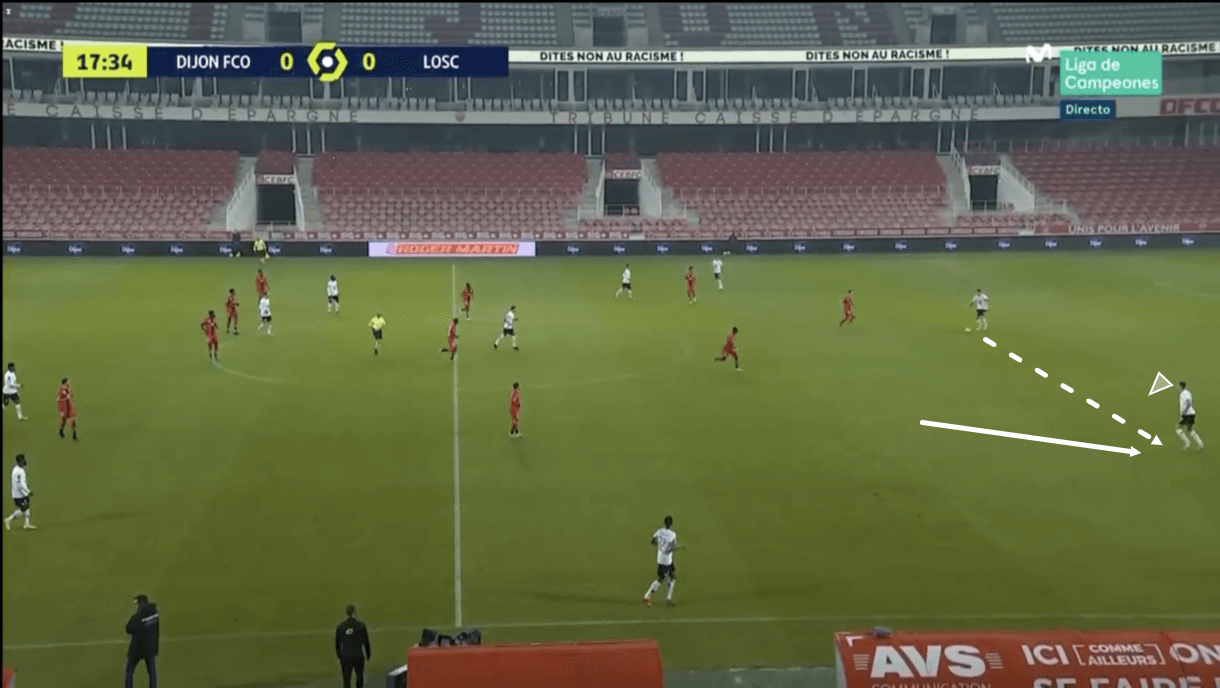
The image above shows us an example of the kind of position that Botman will typically occupy during the build-up.
The Dutchman had been positioned slightly higher up but just before this image, he dropped into this slightly deeper position and that is a common off-the-ball movement to see him make. By doing this just before receiving the ball, he increased the amount of space between himself and the opposition, relieving some pressure, to an extent.
Additionally, dropping slightly deeper like this and relieving pressure allows Botman to take more time on the ball upon receiving the pass so that he can survey the situation more, scanning the pitch to pick out the best possible passing option. He can often be seen taking his time to deliberate and survey the situation on the pitch like this before deciding on a pass.
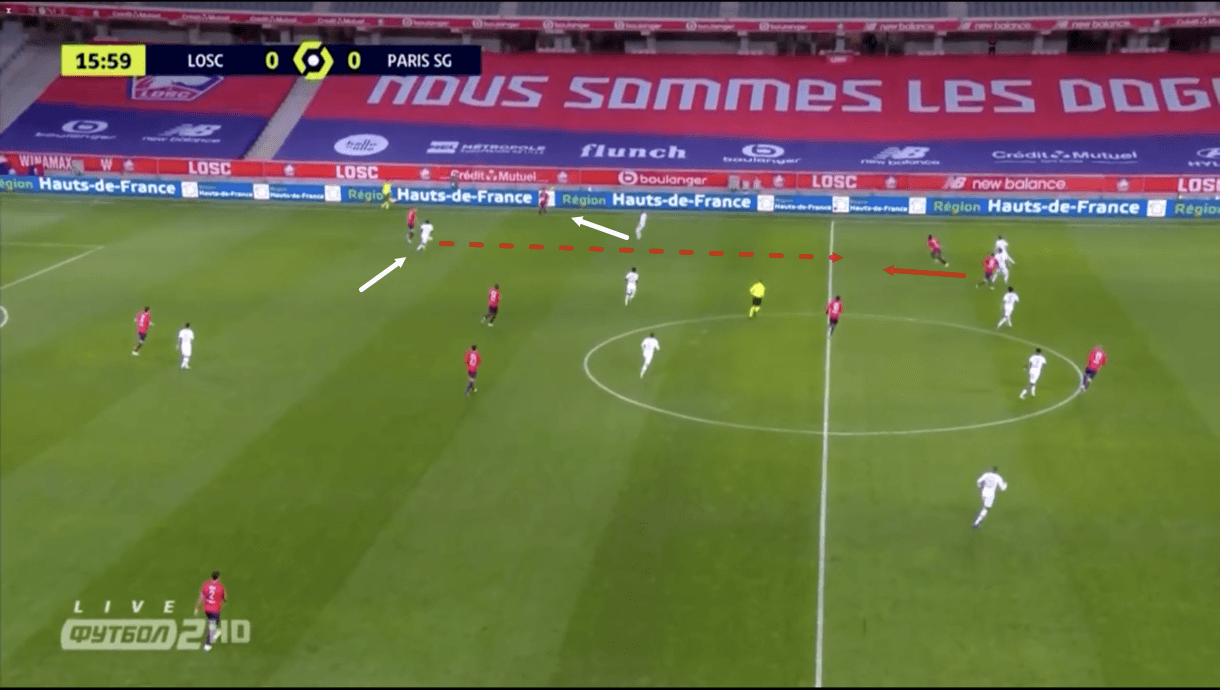
This next image shows us another example of a scenario where Botman has dropped deep and wide, to an extent, before receiving the ball to assess his surroundings and decide on the best option.
As he does so, he attracts some pressure from opposition players, with the right forward applying some pressure to him and the right-winger pushing up and out wide to maintain access to the left-back.
Despite some of the more simple passing options getting cut off and pressure being applied to him, Botman copes well with this situation, remains calm under pressure and manages to pick out a vertical pass to the left-winger dropping deep in between the opposition’s midfield and defensive lines.
By playing this pass, Botman helps Lille to break through two lines of pressure and helps to get the winger in space in a potentially dangerous scenario.
As well as his ability to remain calm under pressure, this passage of play provides an example of Botman’s impressive vision and the effectiveness of his decision to drop deeper, into space to survey more of the pitch before deciding on a passing option, which seemingly paid off on this occasion.
Additionally, this shows us the quality of Botman’s ball-playing ability, with the Dutchman breaking through two lines of pressure with this progressive pass.
However, it’s important to note that Botman’s ball-playing ability is far better when he’s required to play short passes or passes along the ground than it is when he’s required to play long-balls.
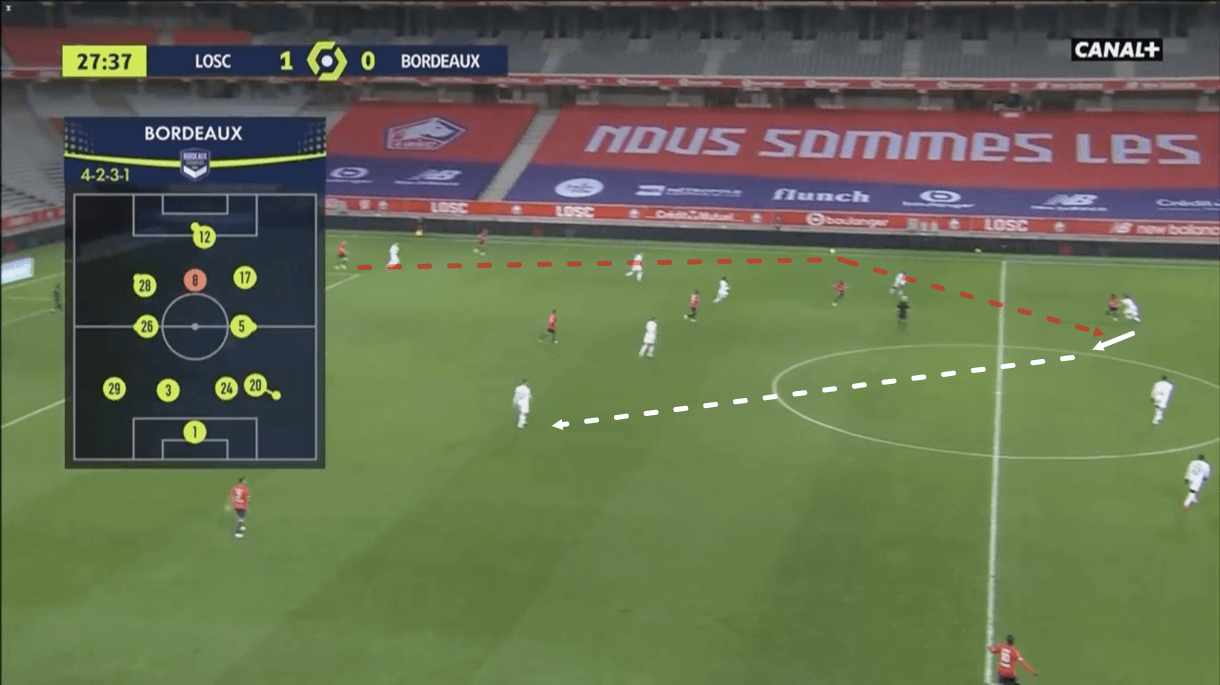
The image above shows us an example of a very similar situation to the one we analysed in the previous image, but on this occasion, the ground passing lane was blocked off and Botman was forced to play a long-ball by opposition pressure.
As he did so, he played the ball into a very similar area we saw him play the ball in the previous image, but on this occasion, the intended target of the Lille attacker was unable to get onto the end of the pass, as he was beaten to the ball by the opposition defender.
The difference in quality between Botman’s long-ball here and his ground pass in the previous image is not a one-off. There has been a notable difference between the quality of the Dutchman’s long-balls compared to other passes this season.
While the 20-year-old plays an important role in his side’s build-up play and plays a large number of progressive passes, Botman’s long-passing quality may be a somewhat notable weakness to his game.
The Dutchman has played the fourth-highest number of long-balls per 90 of any Lille player this season (5.74) but he’s only got the 14th-highest long-ball success percentage of any Lille player (49.09%). This is lower than Lille’s average long-ball success percentage of 55.5% for the 2020/21 campaign.
Plenty of the centre-back’s attempted long-balls miss the mark or are poorly weighted. This element of his game can be exploited by teams cutting off his short passing options effectively via pressure as Bordeaux did in this image above.
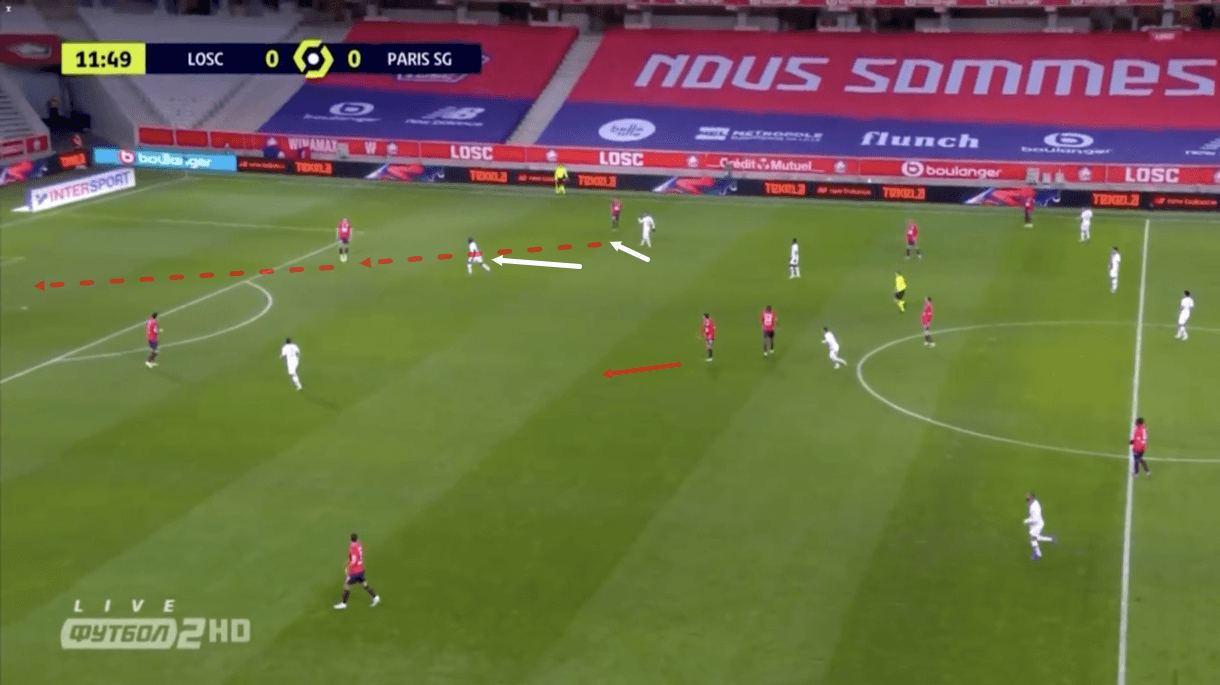
Another example of Botman being put under significant pressure on the ball can be seen in the next image, where, versus PSG, the Dutchman was frequently pressed in a way that cut off passing options to his left and attempted to prevent him from taking the ball onto his left foot in a position to play a progressive pass.
Though this wasn’t always achieved by PSG, they did cause Botman a lot of problems and, as a result, stifled Lille’s build-up play, via this pressure.
In the image above, we can see that Botman is unable to move the ball onto his left foot due to the opposition pressure, but we can see a decent potential passing angle into the centre of the pitch opening up on his right foot.
However, the centre-back avoided playing the ball with his right foot and instead went all the way back to the goalkeeper. This highlights another potential negative to Botman’s game on the ball that could be exploited, as PSG did, – his one-footedness.
Botman’s aerial duels
Last but not least, another major element of Botman’s game is his ability in the air. He has won 5.8 aerial duels per 90 this term in Ligue 1, more than all but three other centre-backs, and he’s got an aerial duel success percentage of 71.43% in France’s top-flight this season.
Botman’s imposing size undoubtedly plays a significant role in his impressive aerial ability, with the centre-back towering over the majority of opposition players and obtaining more strength than the majority of players. As well as being bigger and stronger than most opposition players, the Dutchman is well aware of how to use his size and physicality when entering into aerial duels.
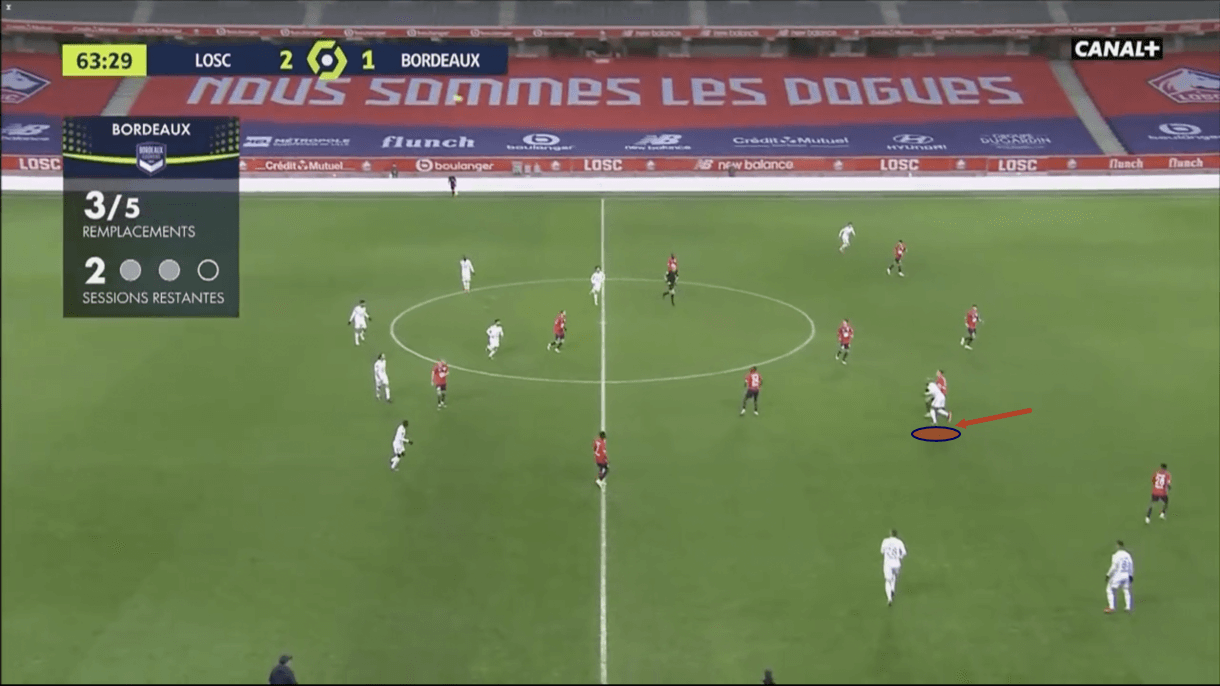
We see an example of Botman engaging in an aerial duel from an opposition goal-kick in the image above. Due to his quality in the air, he steps out of the backline to contest this duel with the striker positioned just in between the defensive line and the midfield line.
As he approaches this player, he immediately steps into him, going shoulder to shoulder and throwing him off balance. Due to Botman’s considerable size and strength, there’s only going to be one outcome of going shoulder to shoulder with him like this in the vast majority of situations and this particular example is no different, with the striker losing out on the physical battle and thus entering the aerial duel at a disadvantage, having been unbalanced and physically dominated.
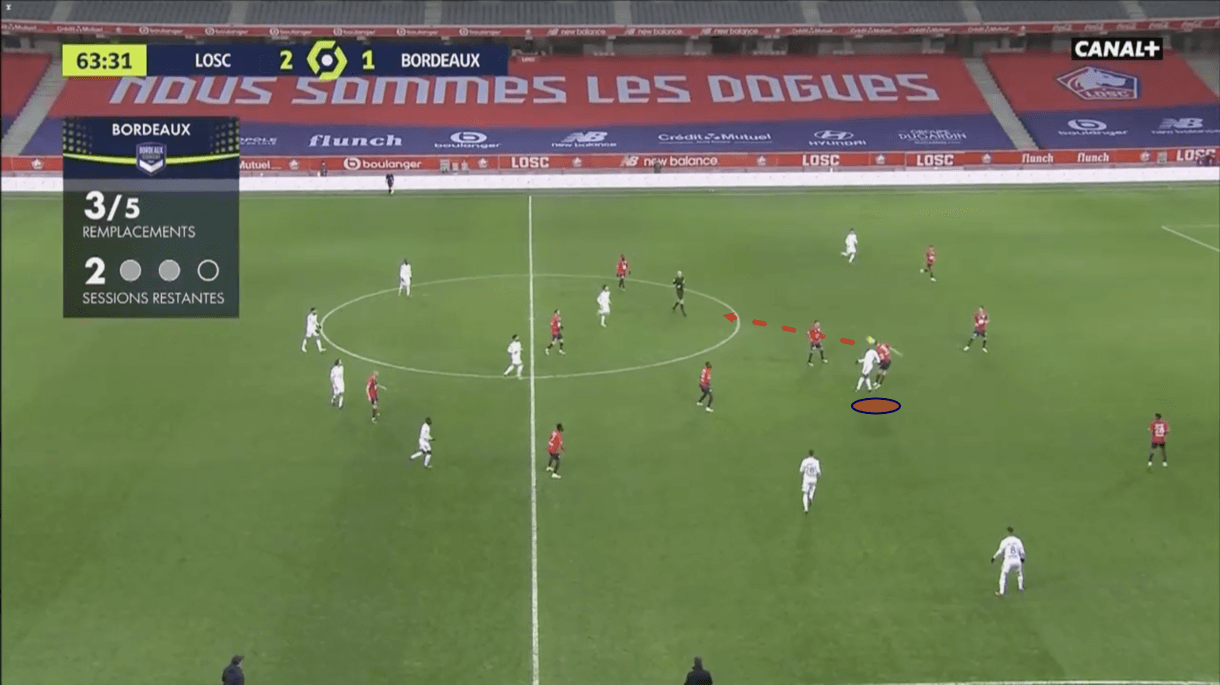
As the ball then drops, Botman is able to get up over the opposition striker and win the duel without too much trouble, sending the ball back upfield for a teammate to compete for higher up the pitch.
This is just one example of Botman’s effectiveness in the air and it’s clear that this is certainly one of his main assets. He’s very good in the air, thanks to his physical assets and his intelligent use of them.
Conclusion
To conclude this scout report, it’s clear that Botman brings a lot to the table both on and off the ball and at 20 years old, represents a very exciting prospect at the centre-back position.
The main positives to his game are his ability to defend 1v1, his aerial ability, his physical strength and his progressive passing quality, particularly with regard to ground passes.
There are some potential areas of improvement in his game, such as his speed, his long-passing ability and his weaker right foot but all in all, it’s clear that Botman has played a significant role in helping Lille to keep the best defensive record in terms of goals conceded in Ligue 1 at this stage of the 2020/21 campaign and the positives of his game, in addition to his potential, vastly outweigh the negatives, in our view.
He may not be the finished product, but he’s certainly a world-class prospect.





Comments